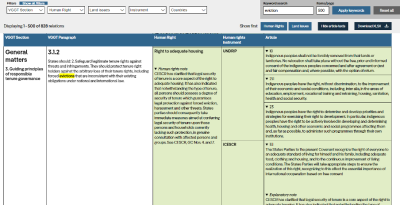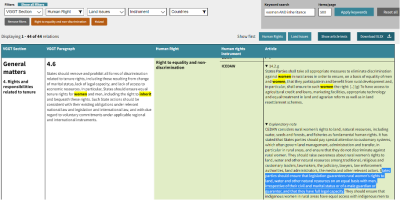Use cases
Check out a specific example of how the tool can be used to secure land rights.
Use Case 1: Eviction from forest areas – how can human rights help?
Imagine you are supporting a community who have been forced out of their ancestral forest. They have been living in the forest for generations. The forest is part of their identity, it is the source of their livelihoods and culture. Your organization is asked to support them in claiming back what they perceive to be their legitimate rights to the forest and the land.
The Human Rights & Land Navigator gives you a shortcut to exploring the human rights at stake. You can start from the perspective of the issue - in this case ‘eviction’. Try typing the word ‘eviction’ in the keyword search to see what the VGGT says about this issue. Then click to “show article texts” to see how human rights instruments deal directly with this issue.

You will then quickly see that the VGGT 3.1.2 instructs States to “Safeguard legitimate tenure rights against threats and infringements. They should protect tenure right holders against the arbitrary loss of their tenure rights, including forced evictions that are inconsistent with their existing obligations under national and international law”.
You will also see that forcibly removing people from their land would infringe on several human rights including the right to housing (enshrined in for example ICESCR Article 11.1). If the community identifies as indigenous, UNDRIP Article 10 is particularly relevant and specifies that “Indigenous peoples shall not be forcibly removed from their lands or territories. No relocation shall take place without the free, prior and informed consent of the indigenous peoples concerned and after agreement on just and fair compensation and, where possible, with the option of return”.
In this way, the Human Rights & Land Navigator can help build your legal arguments and will give you a basis for applying a human rights-based approach to advocacy or litigation.
The Ogiek community in Kenya struggled for almost two decades to have the rights to their ancestral forest recognized by the African Court of Human and Peoples Rights. The Ogiek community had faced arbitrary forced evictions from their ancestral land in the Mau Forest by the Kenyan Government, without consultation or compensation. This loss of land often came from state-sponsored conservation efforts, resulting in the forced eviction of the Ogiek communities from their ancestral lands and the denial of access to the forest resources upon which they depend for their survival. This had a detrimental impact on the pursuit of their traditional lifestyle, religious and cultural life, access to natural resources and their very existence as an indigenous people. Ogiek have a spiritual, emotional and economic attachment to the forest and rely on it for food, shelter and identity.
In 2017, the African Court of Human and Peoples Rights found that the Kenyan government violated several rights of the Ogjek community, including the right to life, the right to freedom of religion, the right to property, the right to enjoy one’s culture, and the right to development.
This case shows how international human rights standards and institutions can effectively safeguard land rights of vulnerable or marginalized communities. The Human Rights & Land Navigator allows you to explore relevant human rights standards and international human rights instruments, that can inform legal action and strengthen advocacy efforts for your land claims.
Use Case 2: Widow’s rights to access land – how can human rights help?
As an NGO fighting for women’s rights in rural areas in for example Malawi, you see many women denied ownership of and access to their deceased husband’s land. They have cultivated crops on this land for years, to feed their family and to earn some income by selling part of the harvest. When their spouses pass away, the land is taken by their husband’s brother or other male family members. By losing access to and control over the land, these women have lost their main source of livelihood, and are left without food and income. You’re convinced their land claims are legitimate and want to know how international law might back up these claims.
The Human Rights & Land Navigator can give you a shortcut to exploring how the Voluntary Guidelines for the Responsible Governance of Tenure of Land, Forests and Fisheries (VGGT) address this issue and importantly which human rights are at stake.
Try for example to enter inheritance AND women in the keyword search filter. You will see that Paragraph 4.6 of the VGGT instructs States to “remove and prohibit all forms of discrimination related to tenure rights, including those resulting from change of marital status (…) and ensure equal tenure rights for women and men, including the right to inherit and bequeath these rights.’
This particular paragraph of the VGGT is underpinned by different human rights including the right to equality and non-discrimination. You will also see that the International Convention on the Elimination of All Forms of Discrimination against Women (ICEDAW) obliges States to ‘ensure that legislation guarantees rural women’s rights to land, water and other natural resources on an equal basis with men, irrespective of their civil and marital status or of a male guardian or guarantor’ (see explanatory note article 14.2g).

Hence, the right to land that these women are claiming is supported in the internationally adopted VGGT and is underpinned by several international human rights instruments ratified by Malawi (such as ICEDAW). You can build your arguments around these State’s obligations to fight for the rights of these women
